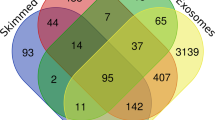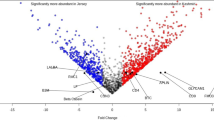Abstract
Amino acids are ubiquitous components of bovine milk. However, systematic analyses of the full spectrum of amino acids in different domains of bovine colostrum and mature milk are relatively scarce. Using metabolomics methods based on iTRAQ combined with HPLC–MS/MS, we analyzed free amino acids in bovine colostrum (FBC) and bovine mature milk (FBM), and insoluble-proteome amino acids in bovine colostrum (IPBC) and bovine mature milk (IPBM). Overall, 33, 31, 29, and 30 amino acids were identified in FBC, FBM, IPBC, and IPBM, respectively. Additionally, 28 and 12 significantly different amino acids were found in the FBC vs. FBM and IPBC vs. IPBM groups, respectively, as well as 38 and 28 significantly different metabolic pathways. The free and insoluble-proteome amino acid profiles differed notably between different lactation stages, and their combination provides a better understanding of the biochemical processes in bovine milk. These results enhance our understanding of amino acids in the different domains of bovine colostrum and mature milk, and provide research directions for the development of milk powder.






Similar content being viewed by others
References
Christensen H (1990) Role of amino acid transport and countertransport in nutrition and metabolism. Physiol Rev 70:43–77. https://doi.org/10.1152/physrev.1990.70.1.43
Lin R, Liu W, Piao M, Zhu H (2017) A review of the relationship between the gut microbiota and amino acid metabolism. Amino Acids 49:2083–2090. https://doi.org/10.1007/s00726-017-2493-3
Özyurt G, Polat A (2006) Amino acid and fatty acid composition of wild sea bass (Dicentrarchus labrax): a seasonal differentiation. Eur Food Res Technol 222:316–320. https://doi.org/10.1007/s00217-005-0040-z
van der Wielen N, Moughan PJ, Mensink M (2017) Amino acid absorption in the large intestine of humans and porcine models. J Nutr 147:1493–1498. https://doi.org/10.3945/jn.117.248187
Schwab CG, Broderick GA (2017) A 100-year review: protein and amino acid nutrition in dairy cows. J Dairy Sci 100:10094–10112. https://doi.org/10.3168/jds.2017-13320
Unger N, Holzgrabe U (2018) Stability and assessment of amino acids in parenteral nutrition solutions. J Pharmaceut Biomed 147:125–139. https://doi.org/10.1016/j.jpba.2017.07.064
Xu Y, Xiao H (2017) Concentrations and nitrogen isotope compositions of free amino acids in Pinus massoniana (Lamb.) needles of different ages as indicators of atmospheric nitrogen pollution. Atmos Environ 164:348–359. https://doi.org/10.1016/j.atmosenv.2017.06.024
Wu G, Wu Z, Dai Z et al (2013) Dietary requirements of “nutritionally non-essential amino acids” by animals and humans. Amino Acids 44:1107–1113. https://doi.org/10.1007/s00726-012-1444-2
Gu H, Du J, Neto F et al (2015) Metabolomics method to comprehensively analyze amino acids in different domains. Analyst 140:2726–2734. https://doi.org/10.1039/c4an02386b
Liang X, Han H, Zhao X et al (2018) Quantitative analysis of amino acids in human and bovine colostrum milk samples through iTRAQ labeling. J Sci Food Agric 98:5157–5163. https://doi.org/10.1002/jsfa.9032
Baldeón ME, Mennella JA, Flores N et al (2014) Free amino acid content in breast milk of adolescent and adult mothers in Ecuador. Springerplus 3:104. https://doi.org/10.1186/2193-1801-3-104
Zhang Z, Adelman AS, Rai D et al (2013) Amino acid profiles in term and preterm human milk through lactation: a systematic review. Nutrients 5:4800–4821. https://doi.org/10.3390/nu5124800
Isaacs CE, Richard E, Thormar H (1995) Antimicrobial activity of lipids added to human milk, infant formula, and bovine milk. J Nutr Biochem 6:362–366. https://doi.org/10.1016/0955-2863(95)80003-u
Thormar H, Isaacs C, Brown H et al (1987) Inactivation of enveloped viruses and killing of cells by fatty acids and monoglycerides. Antimicrob Agents Chemother 31:27–31. https://doi.org/10.1128/aac.31.1.27
Rezaei R, Wu Z, Hou Y et al (2016) Amino acids and mammary gland development: nutritional implications for milk production and neonatal growth. J Anim Sci Biotechnol 7:20. https://doi.org/10.1186/s40104-016-0078-8
Guo MR, Dixon PH, Park YW et al (2001) Seasonal changes in the chemical composition of commingled goat milk. J Dairy Sci 84:E79–E83. https://doi.org/10.3168/jds.s0022-0302(01)70201-9
Zhang H, Yao J, Zhao D et al (2005) Changes in chemical composition of Alxa Bactrian camel milk during lactation. J Dairy Sci 88:3402–3410. https://doi.org/10.3168/jds.s0022-0302(05)73024-1
Valle E, Pozzo L, Giribaldi M et al (2018) Effect of farming system on donkey milk composition. J Sci Food Agric 98:2801–2808. https://doi.org/10.1002/jsfa.8777
Agostoni C, Carratù B, Boniglia C et al (2000) Free glutamine and glutamic acid increase in human milk through a three-month lactation period. J Pediatr Gastr Nutr 31:508–512. https://doi.org/10.1097/00005176-200011000-00011
Carratù B, Boniglia C, Scalise F et al (2003) Nitrogenous components of human milk: non-protein nitrogen, true protein and free amino acids. Food Chem 81:357–362. https://doi.org/10.1016/s0308-8146(02)00430-2
Mašek T, Krstulović L, Brozić D et al (2014) Cow colostrum and early milk enriched with eicosapentaenoic and docosahexaenoic fatty acid. Eur Food Res Technol 238:635–640. https://doi.org/10.1007/s00217-013-2144-1
Yang M, Cong M, Peng X et al (2016) Quantitative proteomic analysis of milk fat globule membrane (MFGM) proteins in human and bovine colostrum and mature milk samples through iTRAQ labeling. Food Funct 7:2438–2450. https://doi.org/10.1039/c6fo00083e
Yang M, Cao X, Wu R et al (2017) Comparative proteomic exploration of whey proteins in human and bovine colostrum and mature milk using iTRAQ-coupled LC–MS/MS. Int J Food Sci Nutr 68:1–11. https://doi.org/10.1080/09637486.2017.1279129
Yang M, Peng X, Wu J et al (2017) Differential proteomic analysis of milk fat globule membrane proteins in human and bovine colostrum by iTRAQ-coupled LC–MS/MS. Eur Food Res Technol 243:901–912. https://doi.org/10.1007/s00217-016-2798-6
Yang M, Song D, Cao X et al (2017) Comparative proteomic analysis of milk-derived exosomes in human and bovine colostrum and mature milk samples by iTRAQ-coupled LC–MS/MS. Food Res Int 92:17–25. https://doi.org/10.1016/j.foodres.2016.11.041
Cao X, Kang S, Yang M et al (2017) Quantitative N-glycoproteomics of milk fat globule membrane in human colostrum and mature milk reveals changes in protein glycosylation during lactation. Food Funct 9:1163–1172. https://doi.org/10.1039/c7fo01796k
Osorio M, Moloney A, Brennan L, Monahan F (2012) Authentication of beef production systems using a metabolomic-based approach. Animal 6:167–172. https://doi.org/10.1017/s1751731111001418
Ferrandino A, Guidoni S (2009) Anthocyanins, flavonols and hydroxycinnamates: an attempt to use them to discriminate Vitis vinifera L. cv ‘Barbera’ clones. Eur Food Res Technol 230:417. https://doi.org/10.1007/s00217-009-1180-3
Scano P, Murgia A, Demuru M et al (2016) Metabolite profiles of formula milk compared to breast milk. Food Res Int 87:76–82. https://doi.org/10.1016/j.foodres.2016.06.024
Scano P, Murgia A, Pirisi FM, Caboni P (2014) A gas chromatography-mass spectrometry-based metabolomic approach for the characterization of goat milk compared with cow milk. J Dairy Sci 97:6057–6066. https://doi.org/10.3168/jds.2014-8247
Dessì A, Murgia A, Agostino R et al (2016) Exploring the role of different neonatal nutrition regimens during the first week of life by urinary GC–MS metabolomics. Int J Mol Sci 17:265. https://doi.org/10.3390/ijms17020265
Tian H, Zheng N, Wang W et al (2016) Integrated metabolomics study of the milk of heat-stressed lactating dairy cows. Sci Rep UK 6:24208. https://doi.org/10.1038/srep24208
Xi X, Kwok L-Y, Wang Y et al (2017) Ultra-performance liquid chromatography-quadrupole-time of flight mass spectrometry MSE-based untargeted milk metabolomics in dairy cows with subclinical or clinical mastitis. J Dairy Sci 100:4884–4896. https://doi.org/10.3168/jds.2016-11939
Chong J, Xia J (2018) MetaboAnalystR: an R package for flexible and reproducible analysis of metabolomics data. Bioinformatics 34:4313–4314. https://doi.org/10.1093/bioinformatics/bty528
Klein K, Bancher-Todesca D, Graf T et al (2013) Concentration of free amino acids in human milk of women with gestational diabetes mellitus and healthy women. Breastfeed Med 8:111–115. https://doi.org/10.1089/bfm.2011.0155
Qian L, Zhao A, Zhang Y et al (2016) Metabolomic approaches to explore chemical diversity of human breast-milk, formula milk and bovine milk. Int J Mol Sci 17:2128. https://doi.org/10.3390/ijms17122128
Tabatabaie L, Klomp LW, Berger R, de Koning TJ (2010) l-Serine synthesis in the central nervous system: a review on serine deficiency disorders. Mol Genet Metab 99:256–262. https://doi.org/10.1016/j.ymgme.2009.10.012
Mothet J-P, Parent AT, Wolosker H et al (2000) d-Serine is an endogenous ligand for the glycine site of the N-methyl-d-aspartate receptor. Proc Natl Acad Sci 97:4926–4931. https://doi.org/10.1073/pnas.97.9.4926
Yamasaki M, Yamada K, Furuya S et al (2001) 3-Phosphoglycerate dehydrogenase, a key enzyme forl-serine biosynthesis, is preferentially expressed in the radial glia/astrocyte lineage and olfactory ensheathing glia in the mouse brain. J Neurosci 21:7691–7704. https://doi.org/10.1523/jneurosci.21-19-07691.2001
Lee Y-H, Stallcup MR (2009) Minireview: protein arginine methylation of nonhistone proteins in transcriptional regulation. Mol Endocrinol Baltim Md 23:425–433. https://doi.org/10.1210/me.2008-0380
Gary JD, Clarke S (1998) RNA and protein interactions modulated by protein arginine methylation. Prog Nucleic Acid Re 61:65–131. https://doi.org/10.1016/s0079-6603(08)60825-9
Soret J, Bakkour N, Maire S et al (2005) Selective modification of alternative splicing by indole derivatives that target serine-arginine-rich protein splicing factors. Proc Natl Acad Sci USA 102:8764–8769. https://doi.org/10.1073/pnas.0409829102
Ghosh G, Adams JA (2011) Phosphorylation mechanism and structure of serine-arginine protein kinases. FEBS J 278:587–597. https://doi.org/10.1111/j.1742-4658.2010.07992.x
Chen H-M, Muramoto K, Yamauchi F et al (1998) Antioxidative properties of histidine-containing peptides designed from peptide fragments found in the digests of a soybean protein. J Agric Food Chem 46:49–53. https://doi.org/10.1021/jf970649w
Müller-Tidow C, Wang W, Idos GE et al (2001) Cyclin A1 directly interacts with B-myb and cyclin A1/cdk2 phosphorylate B-myb at functionally important serine and threonine residues: tissue-specific regulation of B-myb function. Blood 97:2091–2097. https://doi.org/10.1182/blood.v97.7.2091
Heijman J, Dewenter M, El-Armouche A, Dobrev D (2013) Function and regulation of serine/threonine phosphatases in the healthy and diseased heart. J Mol Cell Cardiol 64:90–98. https://doi.org/10.1016/j.yjmcc.2013.09.006
Ulitsky I, Bartel DP (2013) lincRNAs: genomics, evolution, and mechanisms. Cell 154:26–46. https://doi.org/10.1016/j.cell.2013.06.020
Rardin MJ, He W, Nishida Y et al (2013) SIRT5 regulates the mitochondrial lysine succinylome and metabolic networks. Cell Metab 18:920–933. https://doi.org/10.1016/j.cmet.2013.11.013
Conn JP, Pin J-P (1997) Pharmacology and functions of metabotropic glutamate receptors. Annu Rev Pharmacol 37:205–237. https://doi.org/10.1146/annurev.pharmtox.37.1.205
Stenflo J, Fernlund P, Egan W, Roepstorff P (1974) Vitamin K dependent modifications of glutamic acid residues in prothrombin. Proc Natl Acad Sci 71:2730–2733. https://doi.org/10.1073/pnas.71.7.2730
Wang W, Wu Z, Dai Z et al (2013) Glycine metabolism in animals and humans: implications for nutrition and health. Amino Acids 45:463–477. https://doi.org/10.1007/s00726-013-1493-1
Aota S, Nagai T, Yamada K (1991) Characterization of regions of fibronectin besides the arginine–glycine–aspartic acid sequence required for adhesive function of the cell-binding domain using site-directed mutagenesis. J Biol Chem 266:15938–15943
Bergeron R, Meyer TM, Coyle JT, Greene RW (1998) Modulation of N-methyl-d-aspartate receptor function by glycine transport. Proc Natl Acad Sci 95:15730–15734. https://doi.org/10.1073/pnas.95.26.15730
Kirsch J, Betz H (1998) Glycine-receptor activation is required for receptor clustering in spinal neurons. Nature 392:717–720. https://doi.org/10.1038/33694
Lynch JW (2004) Molecular structure and function of the glycine receptor chloride channel. Physiol Rev 84:1051–1095. https://doi.org/10.1152/physrev.00042.2003
Adachi S, Nagano S, Ishimori K et al (1993) Roles of proximal ligand in heme proteins: replacement of proximal histidine of human myoglobin with cysteine and tyrosine by site-directed mutagenesis as models for P-450, chloroperoxidase, and catalase. Biochemistry US 32:241–252. https://doi.org/10.1021/bi00052a031
Jia G, Feng Z, Wei C et al (2009) Dynamic insight into the interaction between porphyrin and G-quadruplex DNAs: time-resolved fluorescence anisotropy study. J Phys Chem B 113:16237–16245. https://doi.org/10.1021/jp906060d
Huxtable R (1992) Physiological actions of taurine. Physiol Rev 72:101–163. https://doi.org/10.1152/physrev.1992.72.1.101
Goedhart A, Bindels J (1994) The composition of human milk as a model for the design of infant formulas: recent findings and possible applications. Nutr Res Rev 7:1–23. https://doi.org/10.1079/nrr19940004
Stapleton PP, Charles RP, Redmond HP, Bouchier-Hayes DJ (1997) Taurine and human nutrition. Clin Nutr 16:103–108. https://doi.org/10.1016/s0261-5614(97)80234-8
Verner AM, McGuire W, Craig J (2007) Effect of taurine supplementation on growth and development in preterm or low birth weight infants. Cochrane Database Syst Rev. https://doi.org/10.1002/14651858.cd006072.pub2
Acknowledgements
This work was supported by the by National Key R & D Program of China (Grant Number: 2018YFC1604302), “Twelfth Five Year” National Science and Technology Plan Project (Grant Number: 2013BAD18B03), and Shenyang Technological Innovation Project (Grant Number: Y17-0-028).
Author information
Authors and Affiliations
Corresponding authors
Ethics declarations
Conflict of interest
There are no conflicts to declare.
Compliance with ethics requirements
The collection of milk samples was approved by Shenyang Agricultural University and the Chinese Human Research Ethical Committee (Permit Number: 2018-966) and was conducted in accordance with the Declaration of Helsinki and the Nuremberg Code. All experiments were performed according to Chinese laws and institutional guidelines.
Additional information
Publisher's Note
Springer Nature remains neutral with regard to jurisdictional claims in published maps and institutional affiliations.
Electronic supplementary material
Below is the link to the electronic supplementary material.
Rights and permissions
About this article
Cite this article
Li, M., Li, W., Kong, F. et al. Metabolomics methods to analyze full spectrum of amino acids in different domains of bovine colostrum and mature milk. Eur Food Res Technol 246, 213–224 (2020). https://doi.org/10.1007/s00217-019-03385-y
Received:
Revised:
Accepted:
Published:
Issue Date:
DOI: https://doi.org/10.1007/s00217-019-03385-y




